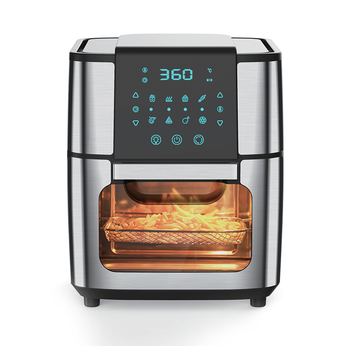Heating Element Placement: Smokeless indoor electric grills are equipped with heating elements that are typically arranged in a uniform pattern beneath the grilling surface. This strategic placement ensures that heat is distributed evenly across the entire cooking area. The consistent placement of the heating elements prevents any cold spots, resulting in more uniform cooking. The elements utilize a coiled or strip configuration, which helps minimize temperature variations across different sections of the grill. Food cooks evenly and efficiently, eliminating the risk of overcooked or undercooked areas.
Reflective Surfaces: Many high-quality smokeless indoor electric grills incorporate reflective materials or surfaces under the cooking plates. These reflectors help redirect and distribute heat more evenly across the grill's cooking surface. By enhancing heat reflection, they ensure that the grilling area remains uniformly heated, even as the grilling surface reaches high temperatures. This results in consistent cooking, especially when grilling larger or thicker pieces of food. The use of reflectors also helps reduce heat loss and boosts overall energy efficiency, contributing to faster cooking times.
Temperature Control Systems: Advanced temperature control mechanisms are integral to ensuring that heat remains stable throughout the cooking process. Many smokeless electric grills are equipped with sophisticated thermostats or digital temperature controls that regulate the grill's heating elements. These systems continuously monitor and adjust the heat to maintain an optimal and consistent temperature. This is particularly beneficial for cooking delicate or temperature-sensitive foods, as the consistent heat prevents the risk of sudden temperature fluctuations that could affect food quality. Some models also allow users to set precise temperature levels for different types of grilling.
Ceramic or Non-stick Coated Grilling Plates: The materials used for the grilling plates play a crucial role in heat distribution. Ceramic-coated or non-stick grilling plates are often employed in smokeless indoor electric grills. These materials are excellent conductors of heat, which helps spread the warmth evenly across the surface. Additionally, ceramic coatings provide superior heat retention, ensuring that the grill maintains a consistent cooking temperature even after food has been added. Non-stick surfaces also minimize the chances of food sticking, making it easier to flip and remove food while preventing uneven cooking that could result from food adhering to hot spots.
Convection Heating: Some smokeless indoor electric grills feature convection heating systems, which use fans to circulate hot air evenly around the grilling surface. This method of heat distribution helps create a more uniform cooking environment, particularly for foods that require heat from all directions, such as roasted vegetables or thicker cuts of meat. The circulating hot air ensures that heat reaches every part of the food, reducing the need for constant repositioning or flipping. This process mimics the effects of an oven's convection setting, but in a more compact, grill-friendly format. It also helps maintain consistent cooking temperatures even when food is placed in different areas of the grill.


 English
English 中文简体
中文简体 English
English 中文简体
中文简体












